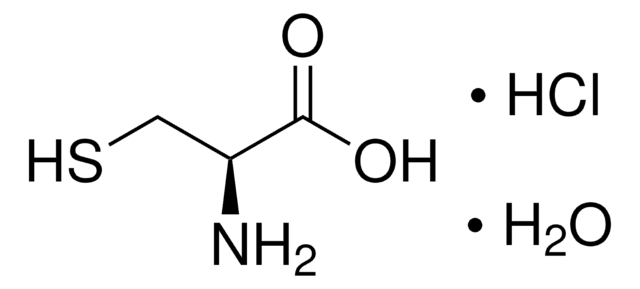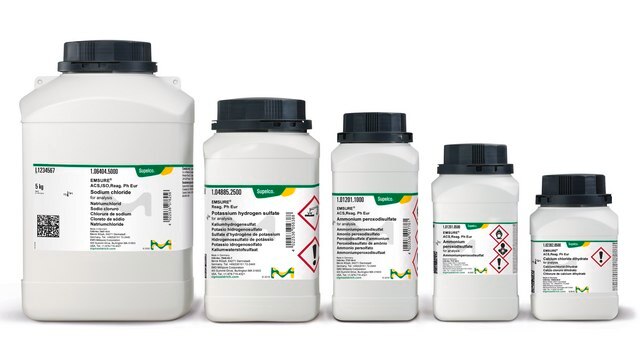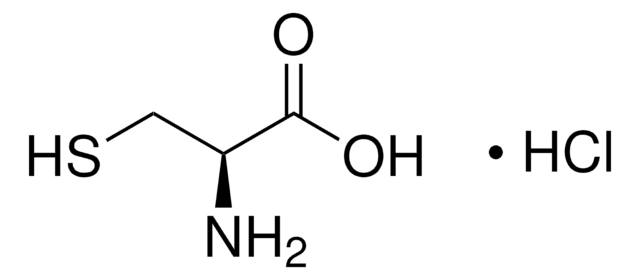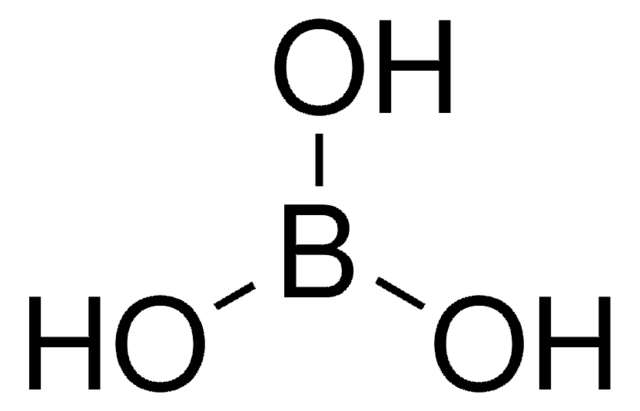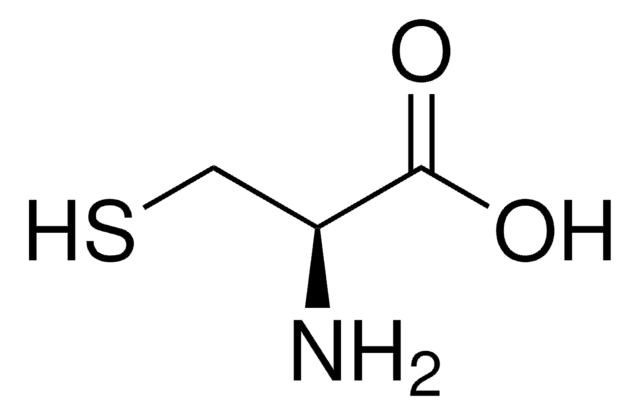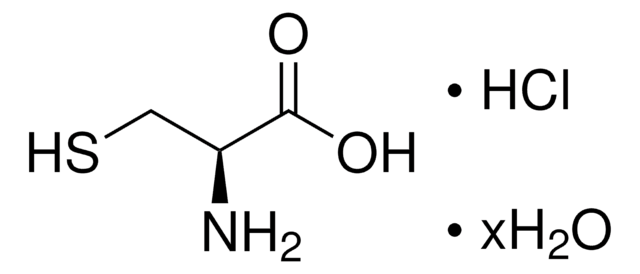1.02839
L-Cystein -hydrochlorid Monohydrat
for biochemistry
Synonym(e):
Cys, L-Cysteiniumchloridmonohydrat, L-Cysteinhydrochlorid, Monohydrat
About This Item
Empfohlene Produkte
Dampfdruck
<0.1 hPa ( 20 °C)
Qualitätsniveau
Assay
98.5-101.0% dry basis (alkalimetric)
Form
crystalline powder
pH-Wert
0.8-1.2 (20 °C, 100 g/L in H2O)
mp (Schmelzpunkt)
168-170 °C
Löslichkeit
650 g/L
Dichte
1.54 g/cm3
Schüttdichte
780 kg/m3
Anionenspuren
sulfate (SO42-): ≤300 ppm
Kationenspuren
Fe: ≤20 ppm
heavy metals (as Pb): ≤10 ppm
Lagertemp.
2-30°C
SMILES String
O.Cl.N[C@@H](CS)C(O)=O
InChI
1S/C3H7NO2S.ClH.H2O/c4-2(1-7)3(5)6;;/h2,7H,1,4H2,(H,5,6);1H;1H2/t2-;;/m0../s1
InChIKey
QIJRTFXNRTXDIP-JIZZDEOASA-N
Suchen Sie nach ähnlichen Produkten? Aufrufen Leitfaden zum Produktvergleich
Verwandte Kategorien
Anwendung
- Smartphone-based Ellman′s colourimetric methods for the analysis of d-penicillamine formulation and thiolated polymer: Demonstrates the application of L-Cysteine hydrochloride monohydrate in developing colorimetric assays for pharmaceutical analysis, enhancing the accessibility and cost-effectiveness of drug quality control (Phadungcharoen et al., 2019).
- The effects of the thiolation with thioglycolic acid and l-cysteine on the mucoadhesion properties of the starch-graft-poly(acrylic acid): Focuses on the modification of polymers with L-Cysteine hydrochloride monohydrate to improve their mucoadhesive properties, which is critical for developing more effective drug delivery systems (Gök et al., 2017).
- On-line pre-reduction of pentavalent arsenicals by thioglycolic acid for speciation analysis by selective hydride generation-cryotrapping-atomic absorption spectrometry: Utilizes L-Cysteine hydrochloride monohydrate in analytical chemistry techniques to improve the detection and measurement of toxic elements in environmental samples, crucial for monitoring and ensuring public health (Musil et al., 2008).
Biochem./physiol. Wirkung
Hinweis zur Analyse
Identität (IR-Spektrum): entspricht
Identität (Chlorid): entspricht
Aussehen: weißes oder fast weißes, kristallines Pulver oder farblose Kristalle
Aussehen der Lösung (25 g/l, Wasser): klar und nicht farbintensiver als die Referenzlösung BY6
Spez. Drehung (α 20/D, 80 g/l, Salzsäure 250 g/l, berechnet auf getrocknete Substanz): +5,5 bis +7,0
Spez. Drehung (α 25/D, 80 g/l, Salzsäure 6 mol/l, berechnet auf getrocknete Substanz): +5,7 bis +6,8
Sulfat (SO₄): ≤ 300 ppm
Schwermetalle (als Pb): ≤ 10 ppm
Fe (Eisen): ≤ 20 ppm
Ähnliche Verbindungen, gesamt (DC): ≤ 0,5 %
Ninhydrin-positive Substanzen (LC)(Verunreinigung (570 nm)): ≤ 0,5 %
Ninhydrin-positive Substanzen (LC)(jegliche Ninydrin-positive Verunreinigung): ≤ 0,2 %
Ninhydrin-positive Substanzen (LC)(Ammonium (570 nm)): ≤ 0,02 %
Ninhydrin-positive Substanzen (LC)(Verunreinigungen gesamt): ≤ 1,0 %
Lösungsmittel-Rückstände (ICH Q3C) ausgeschlossen durch den Herstellungsprozess
Sulfatasche (600 °C): ≤ 0,1 %
Trocknungsverlust (Vakuum < 0.7 kPa, P₂O₅, 24 h): 8.0 - 12.0 %
Bakterielle Endotoxine: ≤ 6,0 IU/g
Lagerklassenschlüssel
11 - Combustible Solids
WGK
WGK 1
Flammpunkt (°F)
Not applicable
Flammpunkt (°C)
Not applicable
Analysenzertifikate (COA)
Suchen Sie nach Analysenzertifikate (COA), indem Sie die Lot-/Chargennummer des Produkts eingeben. Lot- und Chargennummern sind auf dem Produktetikett hinter den Wörtern ‘Lot’ oder ‘Batch’ (Lot oder Charge) zu finden.
Besitzen Sie dieses Produkt bereits?
In der Dokumentenbibliothek finden Sie die Dokumentation zu den Produkten, die Sie kürzlich erworben haben.
Kunden haben sich ebenfalls angesehen
Unser Team von Wissenschaftlern verfügt über Erfahrung in allen Forschungsbereichen einschließlich Life Science, Materialwissenschaften, chemischer Synthese, Chromatographie, Analytik und vielen mehr..
Setzen Sie sich mit dem technischen Dienst in Verbindung.